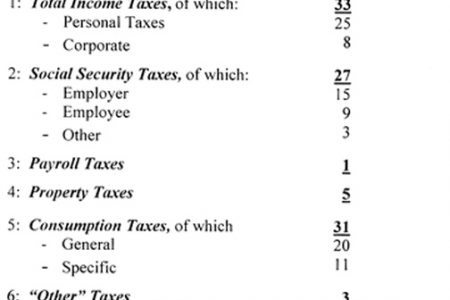
Tax Reform 4: The taxes we do not pay
I have tried to make it clear that my treating with tax reform in my current columns has been deliberate.

I have tried to make it clear that my treating with tax reform in my current columns has been deliberate.

Introduction The mindset of five major groups of stakeholders to the tax reform process (individual taxpayers; the law-making authorities; the public at large as beneficiaries of government spending; the tax administration authorities; corporate and other business taxpayers; as well as organisations like unions, farmers’ organisations, consumer groups and professional associations interested in greater transparency, fairness and efficiency in the tax system) have been briefly described in my two previous columns.

Introduction There is considerable irony to the fact that, as I pointed out last week, less than six months after the Poverty Reduction Strategy Paper (PRSP 2011-15) had highlighted the ongoing Tax Reform Action Plan (TRAP) in force since 2003 as a “tremendous success,” the incoming minority PPP/C administration, in one of its very first deliberate post-elections economic policy actions in December 2011, has established a Tax Reform Committee!

Part I Introduction Beginning last December 4, 2011 my Sunday columns have been re-visiting the global economic and financial crisis that erupted four years ago in light of two basic considerations.

Introduction At the end of 2010 I was expecting global economic recovery, albeit at a reduced rate, to take place during 2011.

Introduction One year ago (November 2010), the 42nd Annual Regional Monetary Studies Conference hosted by the Central Bank of Trinidad and Tobago paid tribute to my research in the field of money and finance.

Introduction In last week’s column I completed a brief description of the ten most important channels through which the negative effects of the global financial crisis and economic recession, which erupted in 2008 impacted Guyana and Caricom.

Introduction Last week’s column indicated that, during the coming weeks, I would be assessing the present state of the global crisis, which began in 2008.

Retrospect When I was first invited by the then Editor-in-Chief David de Caires about a decade ago to write a regular Sunday column for the Stabroek News, which would focus on locating Guyana’s situation in the context of regional and international developments, I readily agreed to undertake this task.

Unconditional, uncapped, untaxed Present official estimates show that more than one in three Guyanese are so poor that such persons regularly have to subsist on less than G350 or US$1.75 per day.

Introduction Last week’s column looked at the intrinsic double-dealing and its associated opportunism, which drives the low carbon development strategy (LCDS) and the Memorandum of Understanding (MOU) between the Government of Guyana and Norway signed in 2009.

Introduction I ended last Sunday’s column with a brief description of the government’s case, which portrays Guyana as a small poor dependent economy confronted with a very difficult international environment yet willing to exchange the global environmental services provided by its pristine forests for compensatory payments through a global exchange mechanism.

Weak and volatile Several analysts have directly blamed the absence of a coherent economic strategy to guide Guyana’s development since the PPP/C administration came to power in 1992, for the volatile and inadequate economic growth which has prevailed since.

Statistical deception Last week I examined one of two recent instances of what I described as official misuse and abuse of Guyana’s economic statistics.

Reputation Among economists, econometricians and statisticians who conduct serious research on the Caribbean and expend considerable effort mining the region’s economic datasets, Guyana has held the unsavory reputation for decades now, of being the country where political manipulation and Government misuse of official statistics are carried to their worst extreme.

Diversification in and out of Sugar This week I finish my examination of the sugar industry that I had started 20 weeks ago (May, 29, 2011).

Introduction The process of consolidating and centralizing capital and other productive assets in Guyana’s sugar industry reached its apogee with the establishment of GuySuCo in 1976.

In last Sunday’s column I sought to portray what I termed as the fundamental economic illogic or contradiction which underlines GuySuCo operations.

While, as the saying goes, there is very little to be gained from crying over spilt milk, the fact of the matter is that the large income transfers made by the EU to Guyana (averaging over 8 per cent of Guyana’s GDP at its peak in the 1990s) when the Sugar Protocol was in force until 2006, have left few positive economic legacies.

Shifting the goalpost In most cases of deliberate political and intellectual deception or expediency, persons and organisations would, as the saying goes, seek to shift the goalpost during the debate, in order to defeat the opposing point of view.
The ePaper edition, on the Web & in stores for Android, iPhone & iPad.
Included free with your web subscription. Learn more.